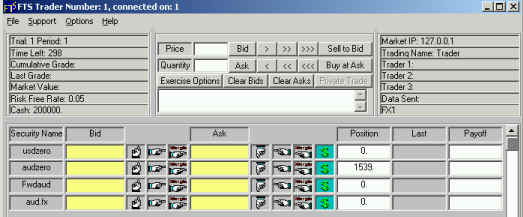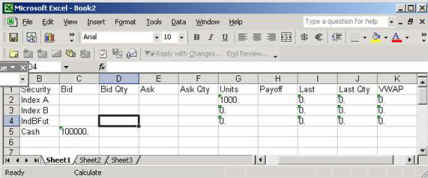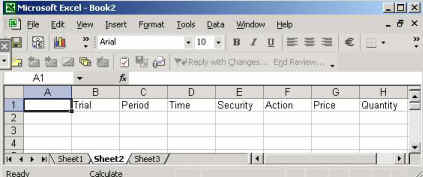Trading Case
FX1
Case Objective
To understand no arbitrage relationships among exchange rates (spot and forward) and interest rates (domestic and foreign).
Key Concepts
Arbitrage free relationships, covered interest rate parity, spot and forward exchange rates.
Case description
In this trading case you will manage a mixed currency position containing both $USD and $AUD. You can have long or short positions in the securities traded, and different traders may have different positions that have equal expected present values. There are four markets open that you can submit market and or limit orders to during the first trading day of a calendar year. At the end of this day time “flashes by” and your position is marked to market in $USD using the realized end of year exchange rate. Both short sales and borrowing in either currency is permitted and at the end of the year your position earns/pays any accrued interest resulting from your day 1 trading activities.
Markets
Opening Trading Screen
The opening screen appears as follows. The markets are described below.

Market 1 is “usdzero.” This market trades a zero coupon bond that pays $USD100 at the end of the year. Market 2 is a zero coupon bond, “audzero,” that pays at year end $AUD100. Market 3 is forward exchange rate market, “fwdaud,” that trades $AUD per 1 unit. That is, a limit order of 0.60/1 if hit implies that at the end of the year the bidder pays $USD0.6 to receive $AUD1. If the realized end of year exchange rate is 0.75 then the bidder pays $USD0.6 and receives $AUD1 which has a marked value of $USD0.75 per unit. As a result, the realized gain from this forward exchange rate transaction for 1 contract equals $USD0.15. If 10,000 units had been traded at this price the realized gain equals USD$1,500. Finally, Market 4 (aud.fx) is a spot exchange rate market. It is quoted in units of $USD per 1 $AUD. That is, a bid of 0.60/1 is a limit order that is offering to pay $USD0.60 for $AUD1. Traders can trade up to 10,000 dollars at a time (a click of the mouse). The screen below illustrates the markets open.
.ht10.jpg" v:shapes="_x0000_i1025" width="576" height="248">
Interest Rates
There
are two money markets in this case. The
first is your Cash account (see Cash: in the above screen with a balance equal
to 200000). This is your current cash
balance in USD. The second, is the
balance under Position beside aud.fx (balance equals 0 in the above
example). This is your current balance
of cash in units of AUD. You can borrow
or lend directly to either money market at the rate of interest that applies to
each currency. This is 0.05 per annum
(compounded annually) for the USD and 0.06 per annum (compounded annually) for
the AUD.
Recall,
the markets are open for day 1 of the year.
As a result, a long position in either money market at the end of the
trading day accrues interest for the year.
Similarly, a short position in either cash account, at the end of the
trading day, pays the interest that accrues for the year. During the trading day balance fluctuations
in either cash account do not attract interest accruals or payments.
The set of possible realizations for the end of year cost of $AUD in units of $USD depends upon the path each economy follows throughout the year. In this case the possible exchange rate realizations lies in the following interval: [0.53, 0.80]. That is, the realized exchange rate is any number between 0.53 and 0.80 with each possible realization being equally likely. It is your task as part of the trading crowd to discover a price for the spot exchange for the first day's trading.
Trading Objective
Your aim is to make as much money as you can which depends upon how well you trade relative to the prices discovered by the market.
Spreadsheet
Support
Step 1: Linking
the FTS Market to your Spreadsheet
Performing spreadsheet link is
simple. First open Excel. In the FTS Trader click on the File Menu item
and then select Excel link.
Next click on the button Find
Excel Workbooks and then select the work book you want to link to. Be sure to link Market Data and Trading
History to two different sheets. Then
click OK. The link is automatically
maintained for you in real time.
Step 2: The fixed spreadsheet cell conventions
If you choose to create a spreadsheet support system
for this trading case the following cell information is relevant:
Suppose
you link to Sheet 1 and sheet 2 as per screen shot below. Sheet 1 maintains a real time link to your
trading screen. Spreadsheet Cols run
from A (blank), B (Security), C (Bid), D (Bid Qty) etc., and rows run from 1
(Headings), 2 (Security 1), 3 (Security 2), 4 (Security 3) etc., for all
securities in the case and then followed by your cash balance.

The above cells are fixed and
general across FTS cases. Once you have
linked to your spreadsheet (which you can do via the file menu item in the FTS
Trader), the first security’s bid comes into cell C2, and so on up until the
VWAP (current volume weighted average price of trades).
Sheet 2: Contains your personal trading
information. Spreadsheet Cols run from A
(blank), B (Trial), C (Period), D (Time) etc., and rows run from 1 (Headings),
2 (first trade), 3 (second trade), etc.,
The details for the second
sheet which contains your personal trading diary are provided below:

Tip: If you are involved in a weekend trading session it is
recommended that you have a third master sheet in your workbook to keep you
personal trading diary in. That is, if
you are logging in and out of the market multiple times you will need to keep
track of your cumulative trading diary because each time you log in the
personal trading diary starts from row 1 (as above) of the sheet you choose to
link to. As a result, if you log in and
out multiple times and want to maintain a cumulative trading record, be sure to
do either i. or ii. below:
i. Attach to a different Sheet each time so that
you have login 1, login 2 etc., recorded in separate spreadsheets or,
ii. At the time of logging
out, copy and paste the data from Sheet 2 to Sheet 3 (assuming you have linked
to Sheet 2 as illustrated above). In
this way you maintain a cumulative record of your trading history in Sheet 2.
Tip: It is a good practice to back up your Excel
Workbook.